Analysis of Sound Power Level Changes Caused by Wheel with Flat Spot Using Numerical and Physical Experiment
Abstract
:1. Introduction
2. Tasks and Objectives of the Work
- -
- Prepare the plan of the experiment, taking into account the overview of the literature;
- -
- Perform the experiment;
- -
- Perform the analysis and compare it with the results of the theoretical model.
3. Sound Power Change Calculation Model and Plan of the Experiment
3.1. Sound Power Change Calculation Model
3.2. Sound Power Change Experiment Plan
4. Physical Experiment
4.1. Description of the Experiment and the Initial Data
- Three cargo trains were measured. Two trains were traveling in the direction State border to Stasylos, and one train was traveling in the direction Stasylos to State border.
- Air temperature +5 °C, wind speed 2 m/s;
- Measurement devices—ATLAS LG system and Bruel and Kjær (Nærum, Denmark) Type 9727 measurement equipment;
- General parameters registered by ATLAS LG:
- Train weight, t; number of wheelsets, pcs.; train length, m; average load ratio; movement speed, m/s; train acceleration, m/s2; train load, t/m; time and date.
- Parameters of each wheelset registered by ATLAS LG:
- Number of axles; alarm signal; maximum force, kN; maximum reduced force, kN; load, t; speed, m/s; distance from the first wheel, m; acceleration deviation from the first wheelset, m/s2; time from the first wheelset, s.
- Sound was measured using Bruel and Kjær Type 9727 measuring equipment (Figure 3a).
- It consists of Type 7910 software (Bruel and Kjær. Nærum, Denmark); multichannel data storage unit Type PULSE 3560-B (Bruel and Kjær. Nærum, Denmark); computer and microphones GRAS 46AE 1/2″ CCP standard field microphone set (range of measured frequencies: 3.15 Hz to 20 kHz, dynamic range: 17 dB (A) to 138 dB [14].
- Sensitivity: 50 mV/Pa, IEC 61672 class 1); three microphones 186157, 190590 and 270029;
- Microphone layout diagram is given in Figure 4.
- Parameters measured by the equipment:
- Sound power, Pa; sound power level of the sound frequencies, dB and Hz.
- Influencing factors/conditions were taken as a benchmark. Changes in sound pressure resulted from changes in wheel force, assuming that the additional factors/conditions remained constant, while only the force changes.
- Track profile data are also acquired from JSC “Lithuanian Railways” and indicated in Figure 5.
4.2. Physical Experiment Measurement Results
4.2.1. ATLAS LG Measurement Results
4.2.2. Sound Measuring Results
4.3. Comparison of Measurements Results with the Calculations of the Mathematical Model of the Numerical Experiment. Results of the Calculations According to the Data of the Physical Experiment
5. Conclusions
Author Contributions
Funding
Institutional Review Board Statement
Informed Consent Statement
Data Availability Statement
Conflicts of Interest
Nomenclature
| Roman | |
| linear coefficient of the energy dependency on the force; | |
| frequency of the wheel defect impact on the rail (Hz); | |
| impact force of a wheel with a defect into a rail (N); | |
| reduced ATLAS LG impact force (N); | |
| reference constant wheel force acting on the rail (N); | |
| reduced ATLAS LG reference force (N); | |
| defect length (m); | |
| length of the wheel working surface (m); | |
| sound pressure change (dB); | |
| length of the wheel rolling surface (m); | |
| sound power level (dB); | |
| sound level from the reduced ATLAS LG force (dB); | |
| sound pressure (Pa); | |
| reference sound pressure (Pa); | |
| coefficient that depends on the number of reflecting surfaces in the environment; | |
| distance from the sound source (m); | |
| wheel radius (m); | |
| defect repetition period (s); | |
| T | time (s); |
| wagon speed (m/s); | |
| full sound source energy (radiated in all directions during the period of time) (W); | |
| reference (background) sound level energy (W). | |
| Greek | |
| wheel angular speed (s−1). | |
References
- Guidelines to Best Practices for Heavy Haul Railway Operations: Wheel and Rail Interface Issues. Available online: https://ihha.net/resources-ihha/ecopy (accessed on 13 January 2020).
- Technical Description of ATLAS-LG System, RAKP Project. ATLAS-LG Requirements for Installation; VAE Eisenb GMBH: Eisenberg, Germany, 2006; Volume 8, p. 0124490769. [Google Scholar]
- ITSS. Vertical Dynamic Load Monitoring System “AGUILA”, Based on Fiber Optic Pressure Sensors; ITSS: Puerto de Sagunto, Spain, 2014. (In Russian) [Google Scholar]
- WILD Wheel Impact Load Detector; Salient Systems, Inc.: Austin, TX, USA, 2020.
- Mobile Monitoring System for Train. In Vehicle and Infrastructure under Real Operating Conditions; Innotec SystemGMBH, Lasca: Hannover, Germany, 2020.
- Shaporov, A.I.; Menshikov, S.A.; Luzin, S.A. System for early diagnostics of bearings of axleboxes of wheelsets of a moving train “acoustic system PAK”. Patent No. RU89053U1, 2009. Available online: https://poleznayamodel.ru/model/8/89053.html (accessed on 28 February 2021). (In Russian).
- Muller MMB. Available online: http://www.muellerbbm-rail.de/produkte/wheel-monitoring-system/ (accessed on 28 February 2021).
- Bollas, K.; Papasalouros, D.; Kourousis, D.; Anastasopoulos, A. Acoustic emission inspection of rail wheels. J. Acoust. Emiss. 2010, 28, 215–228. [Google Scholar]
- Bondarenko, V.V.; Skurihin, D.I. Mobile acoustic control system of wheel sets. World Transp. Transp. 2015, 13, 192–197. Available online: https://mirtr.elpub.ru/jour/article/view/249 (accessed on 28 February 2021). (In Russian).
- Buriak, S.Y. Diagnosing the state of the rolling surface of a wheel of a rolling stock of railways. Sci. Transp. Prog. 2013, 1, 22–29. (In Russian) [Google Scholar] [CrossRef] [Green Version]
- Petrenko, V.; Kukėnas, V. Simplified mathematical model of changes in sound power level caused by the perpendicular forces that arise when the rail contacts the wheel with flat. In Proceedings of the International Conference Transbaltica, Vilnius, Lithuania, 2–3 May 2019; Springer: Cham, Switzerland, 2020; pp. 445–454. [Google Scholar] [CrossRef]
- Kogan, A.Y.; Verkhotin, A.A. Calculation of the impact on the path of a pair of wheels with a slider//Studieson the possibility of increasing train speeds. JSC Vniizht 1984, 5, 31–37. (In Russian) [Google Scholar]
- Thompson, D.; Jones, C. Noise and Vibration from Railway Vehicles. In Handbook of Railway Vehicle Dynamics, 1st ed.; Chapter 10; CRC Press: Boca Raton, FL, USA, 2006; p. 48. [Google Scholar] [CrossRef]
- T. GRAS 46AE 1/2′ CCP Free-field Standard Microphone Set. Description. Available online: https://www.grasacoustics.com/products/measurement-microphone-sets/constant-current-power-ccp/product/140-46ae (accessed on 28 February 2021).

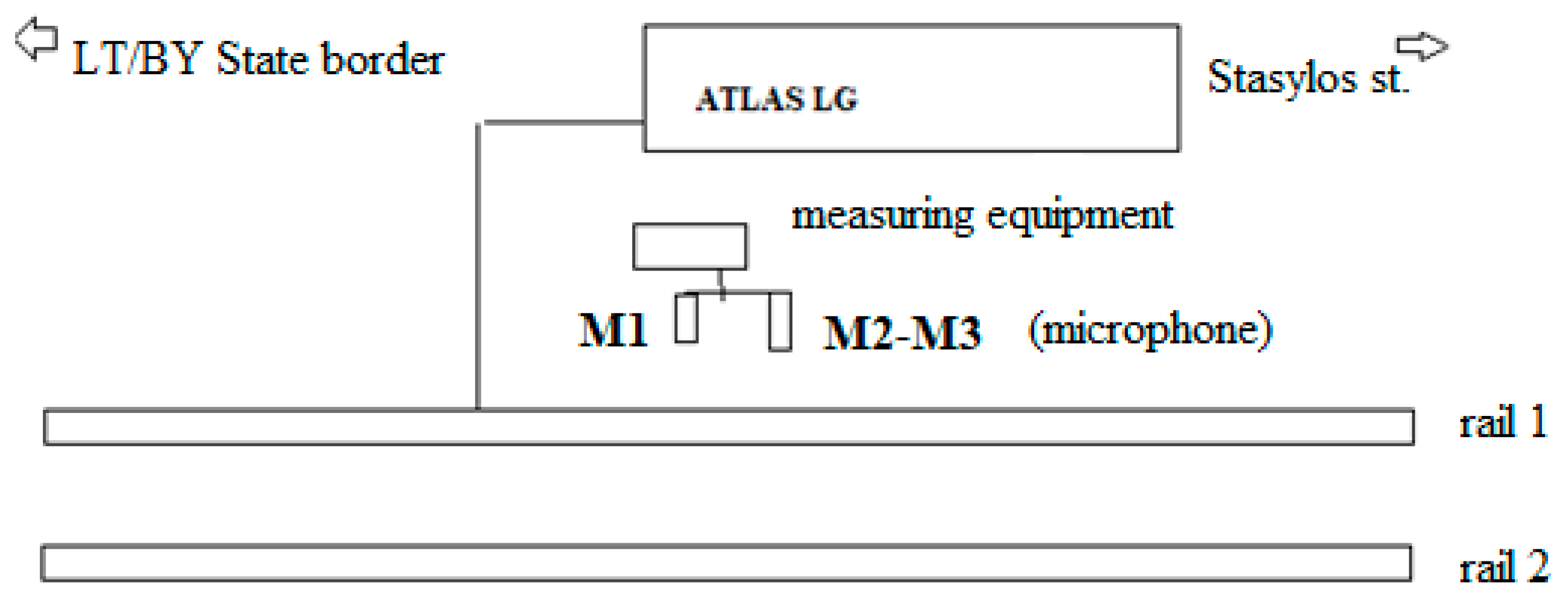
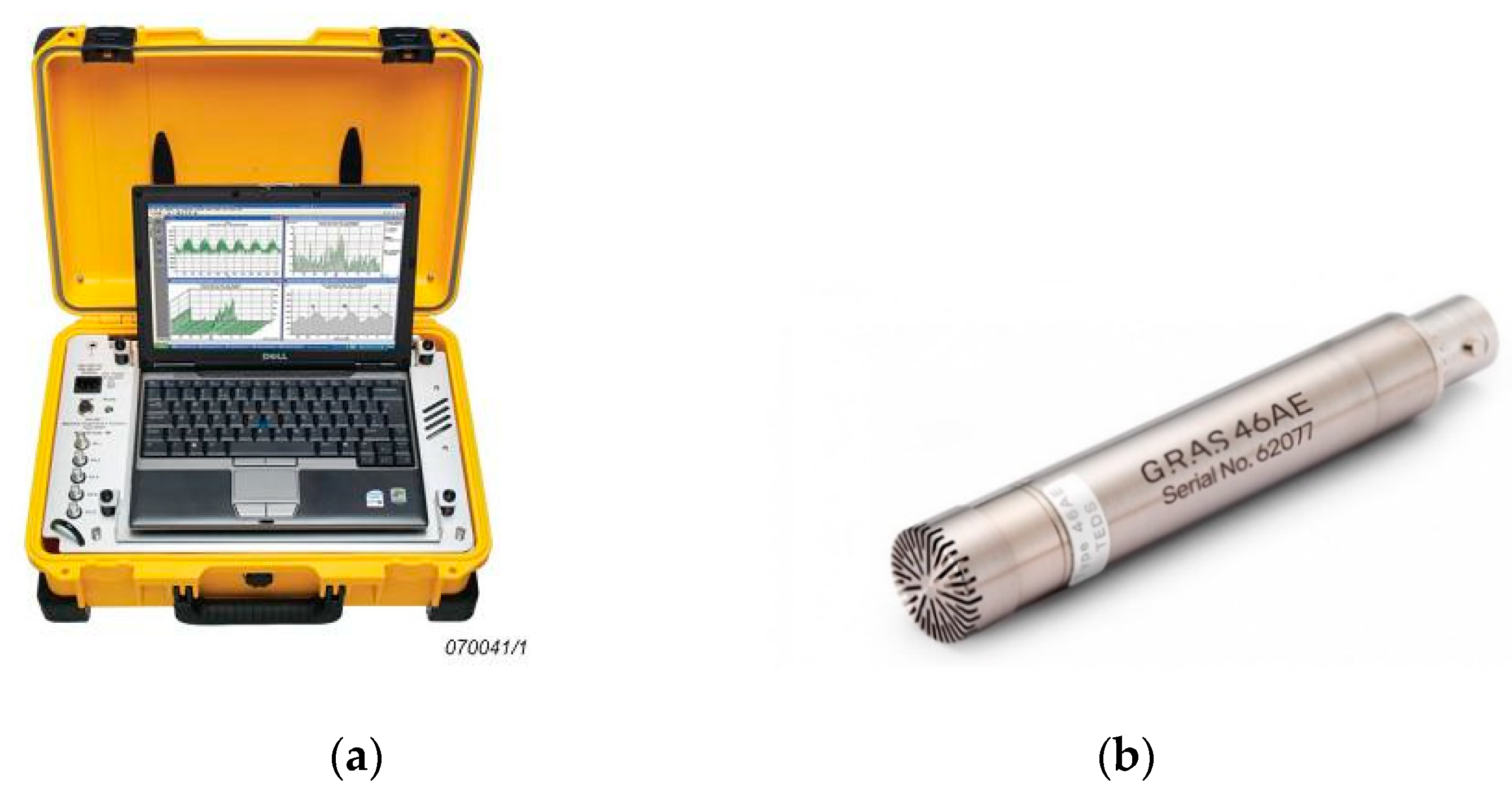
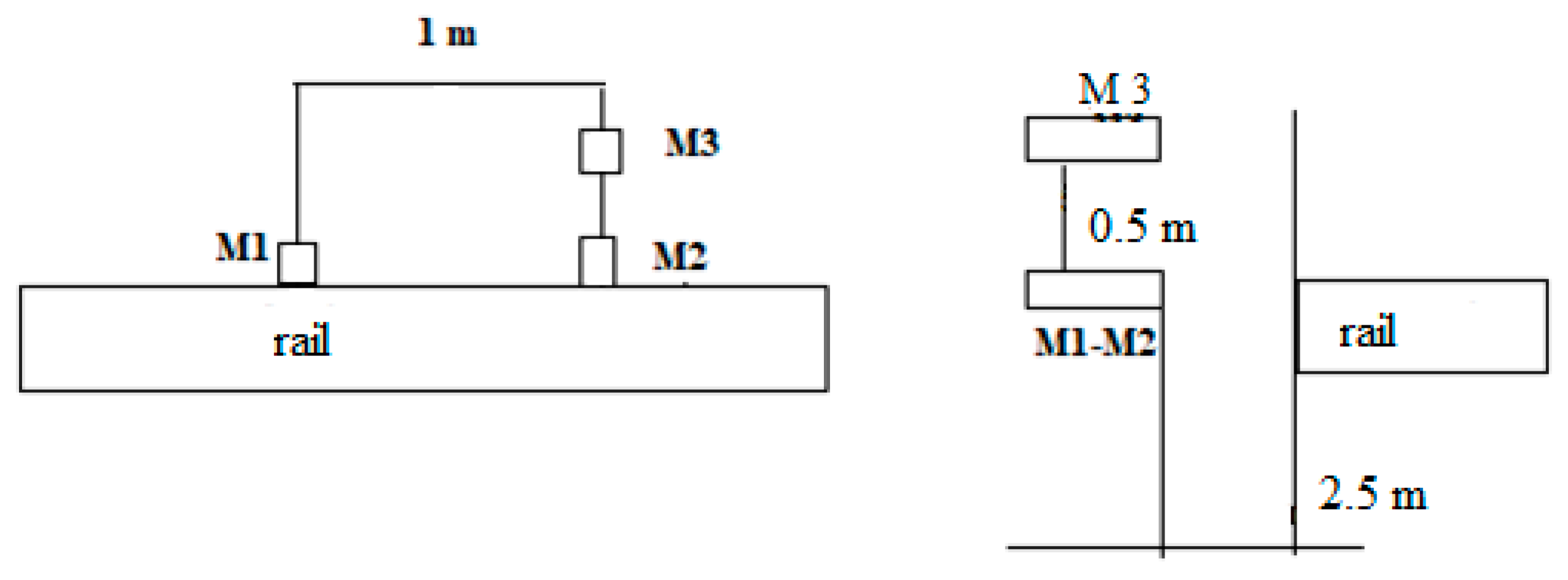


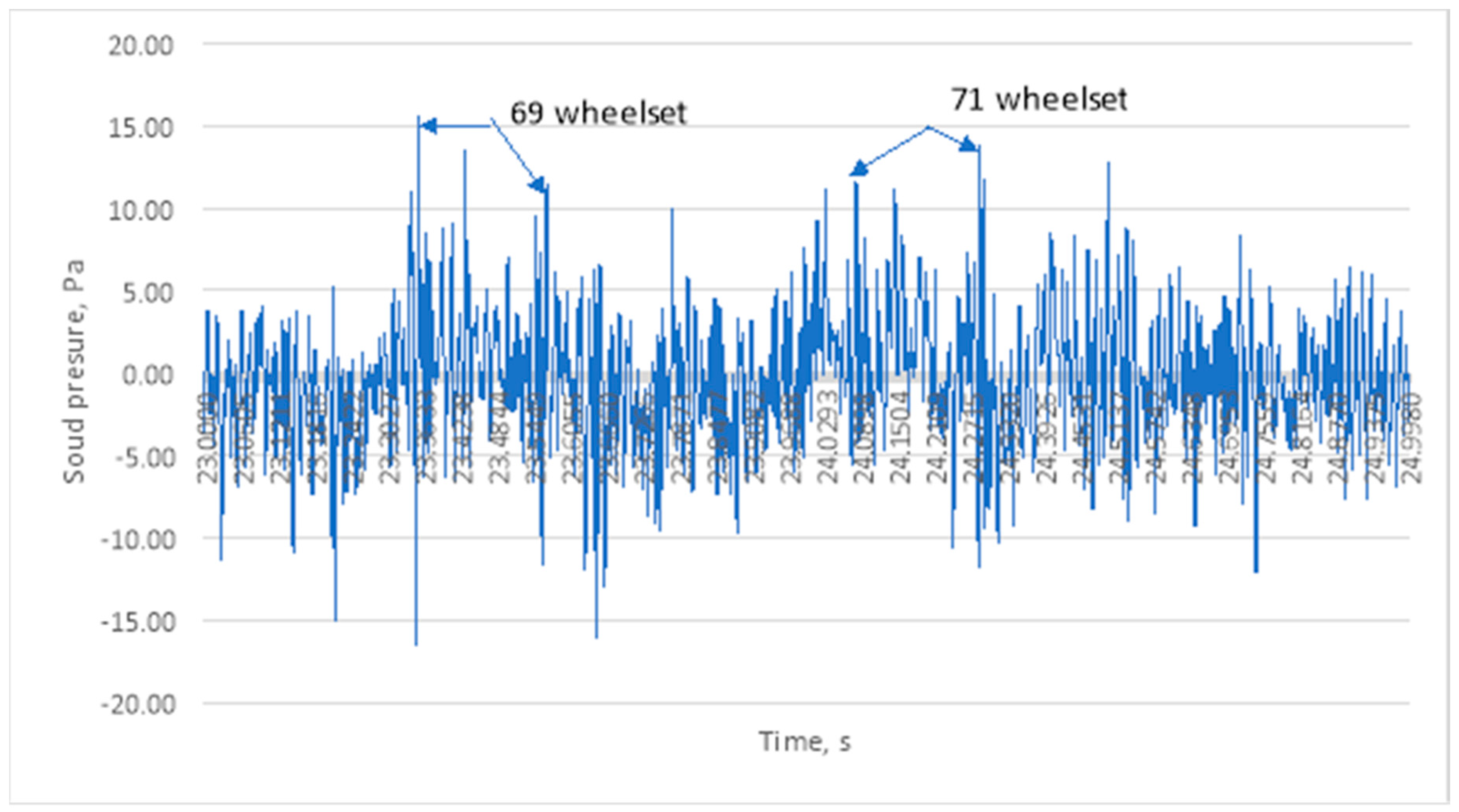
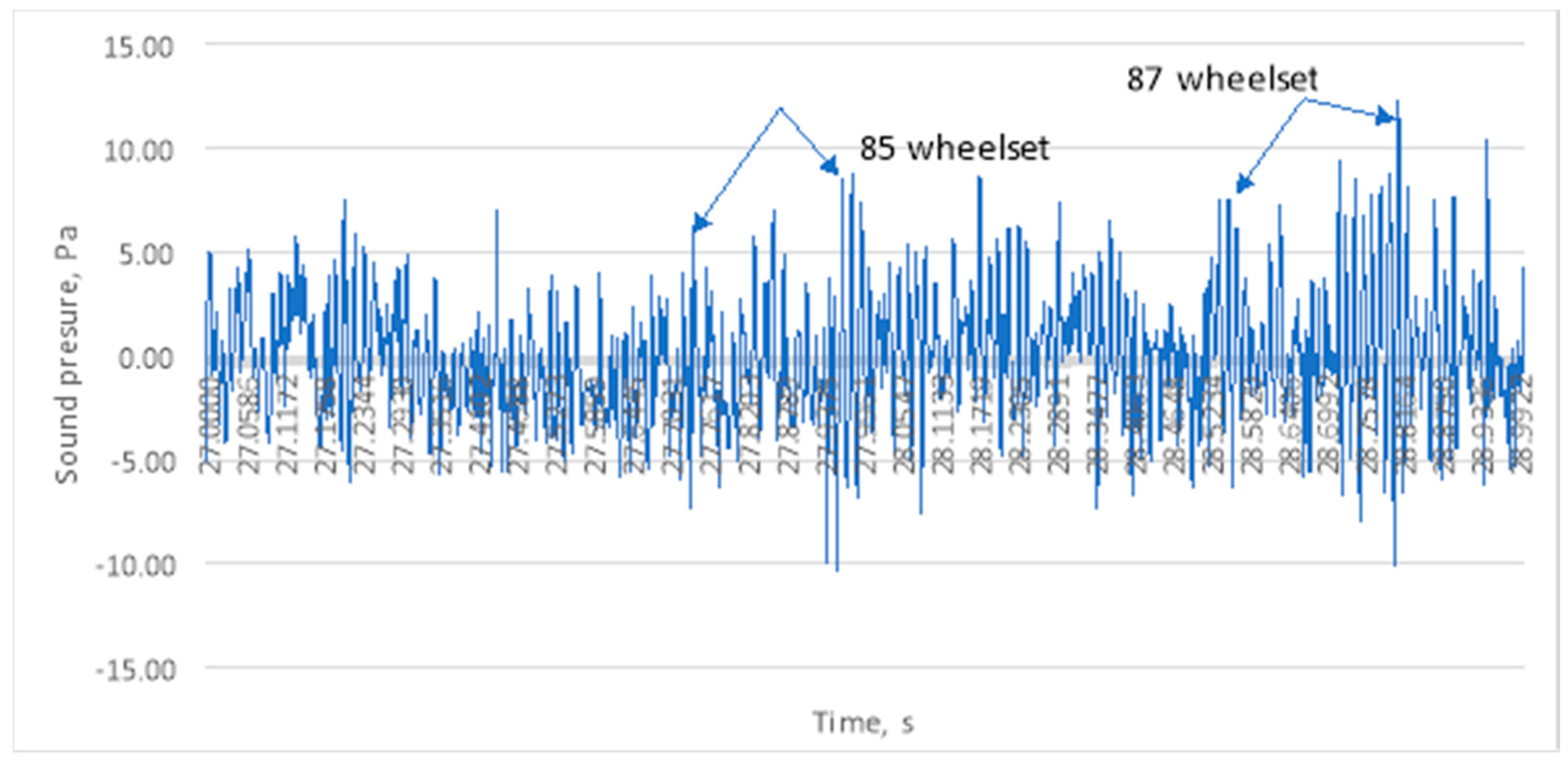

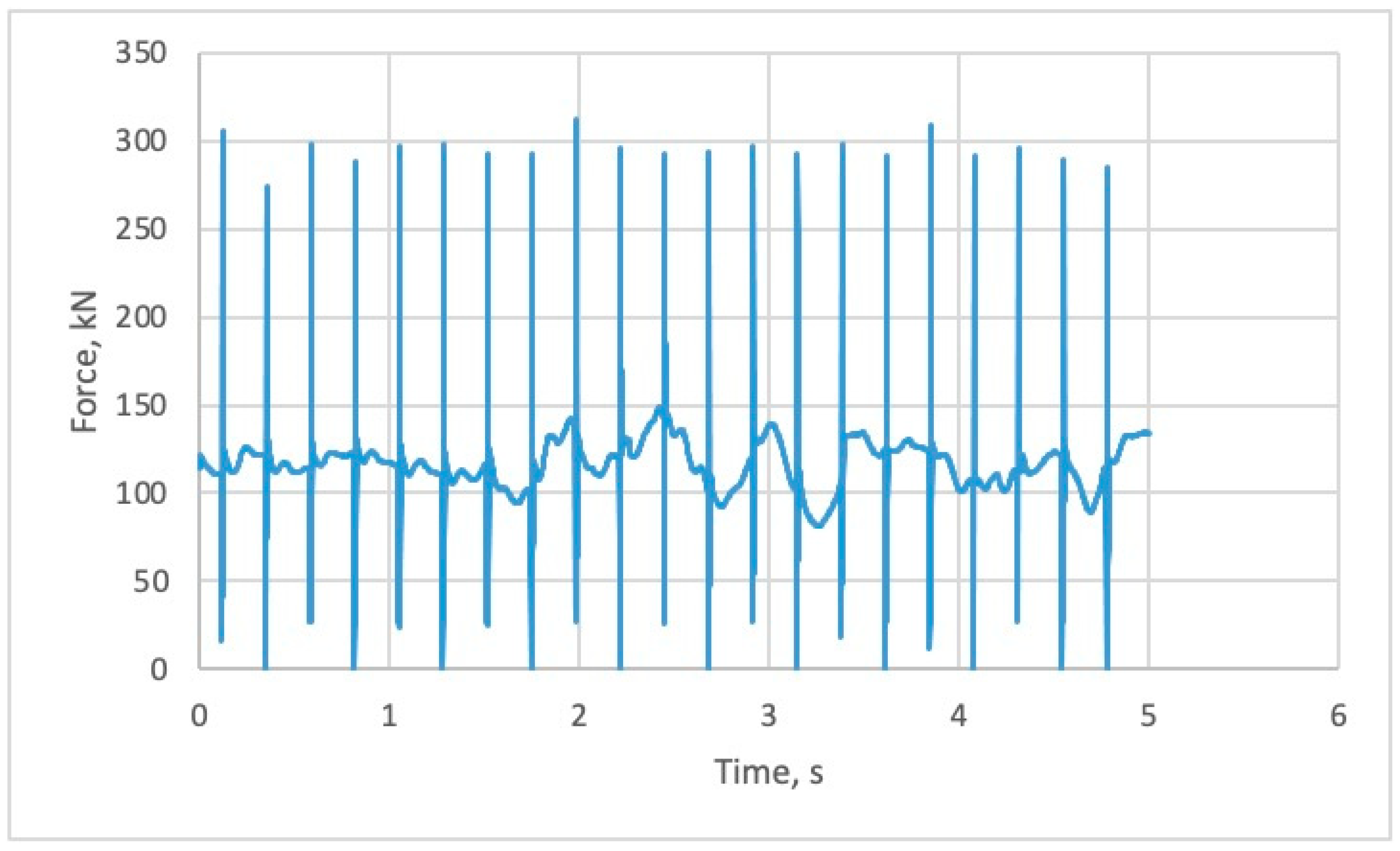

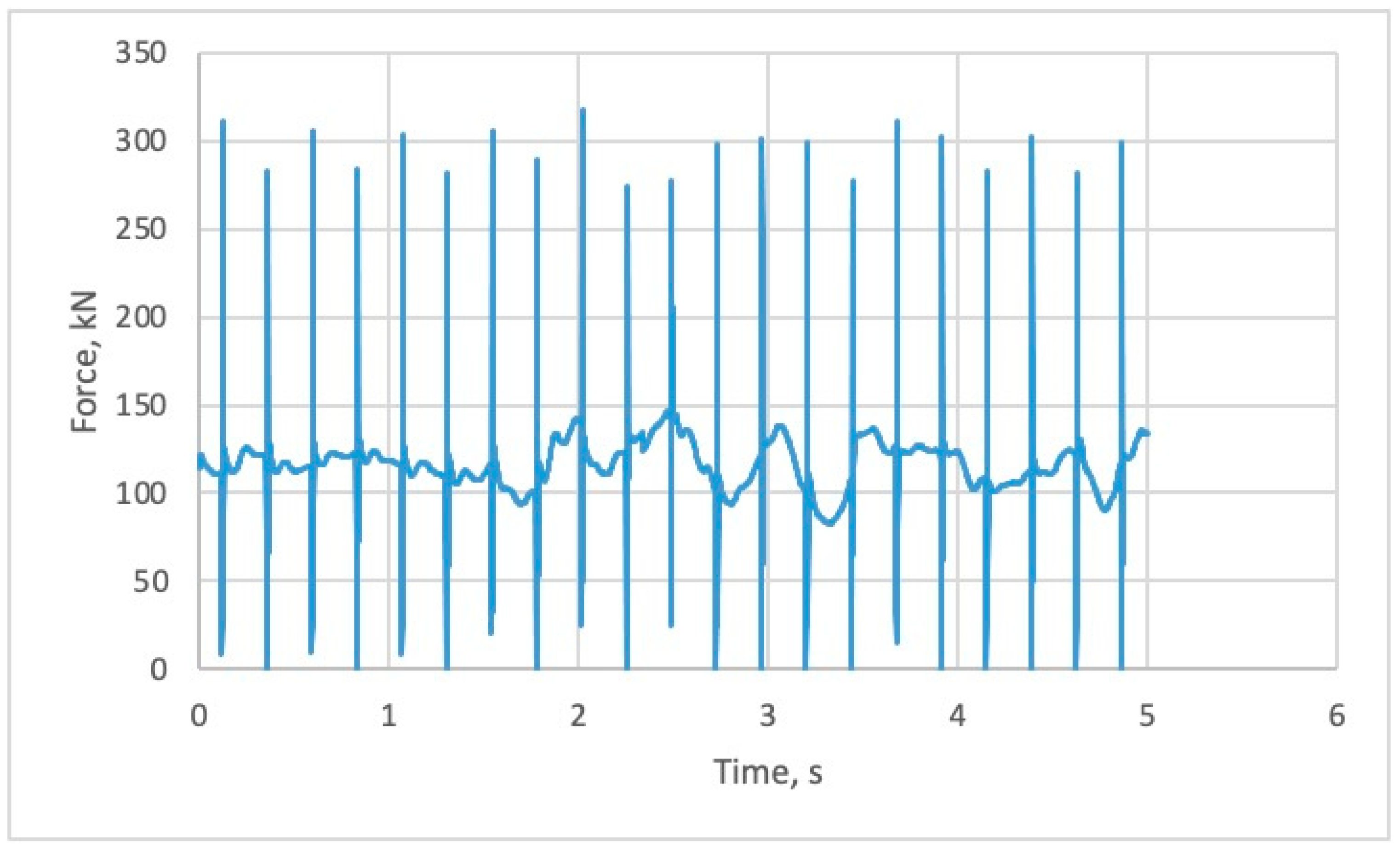
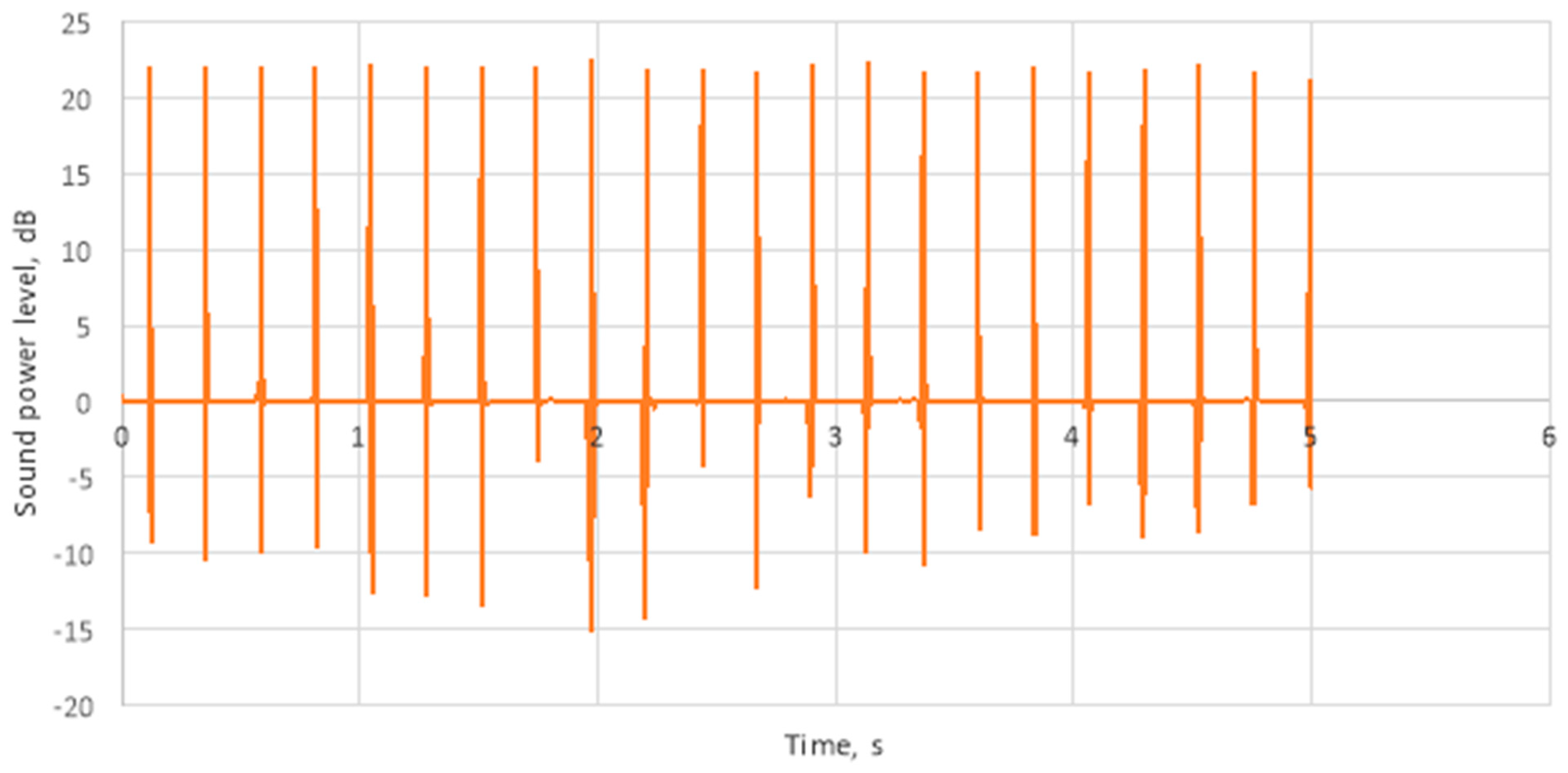
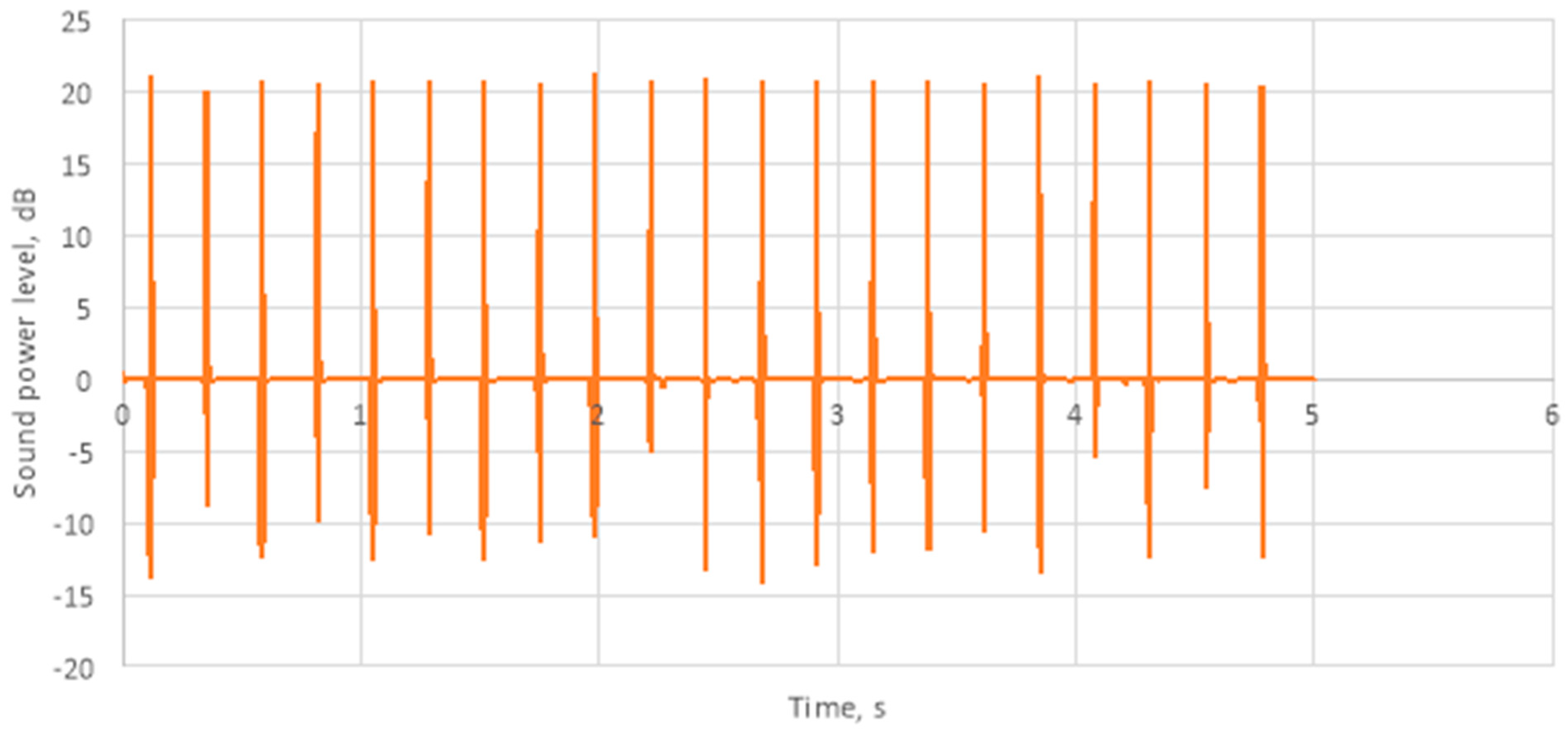
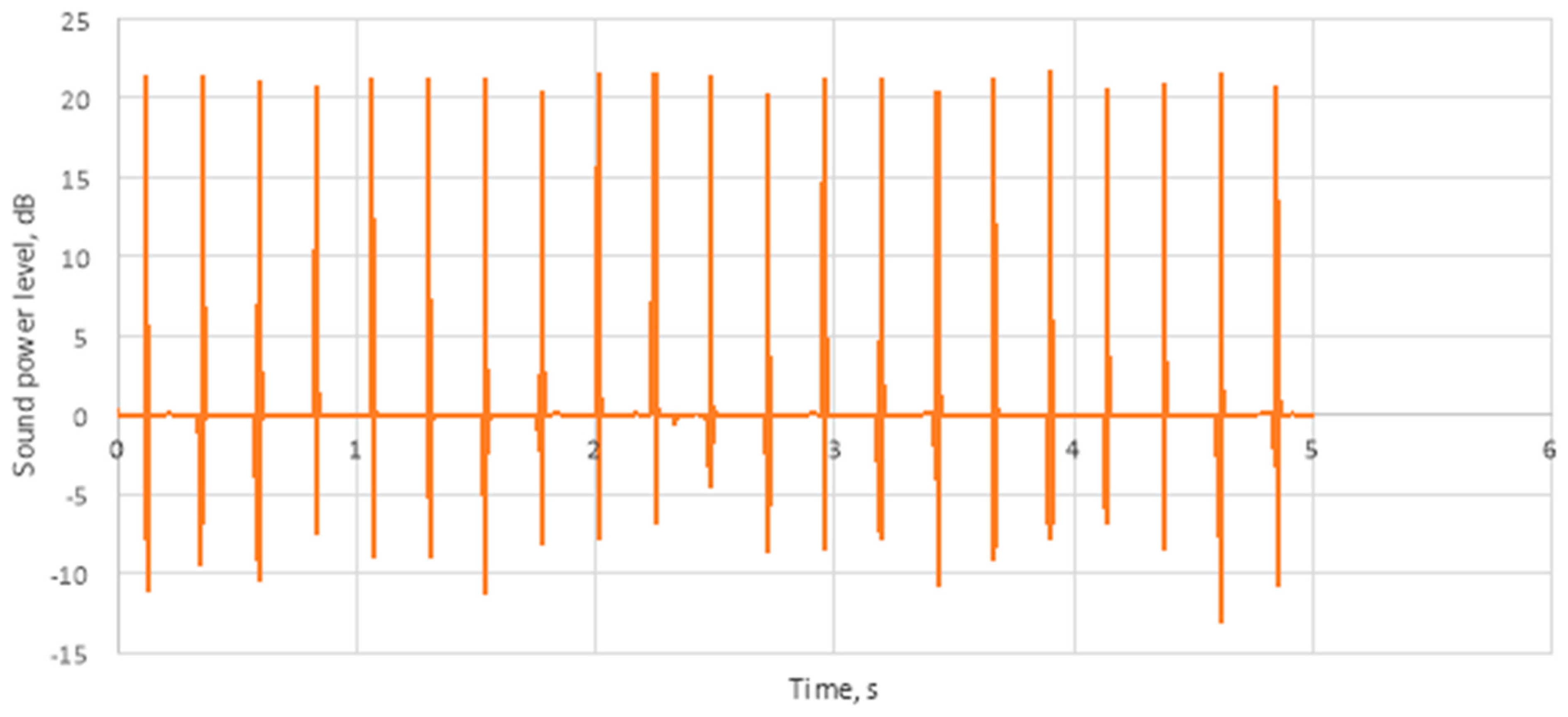
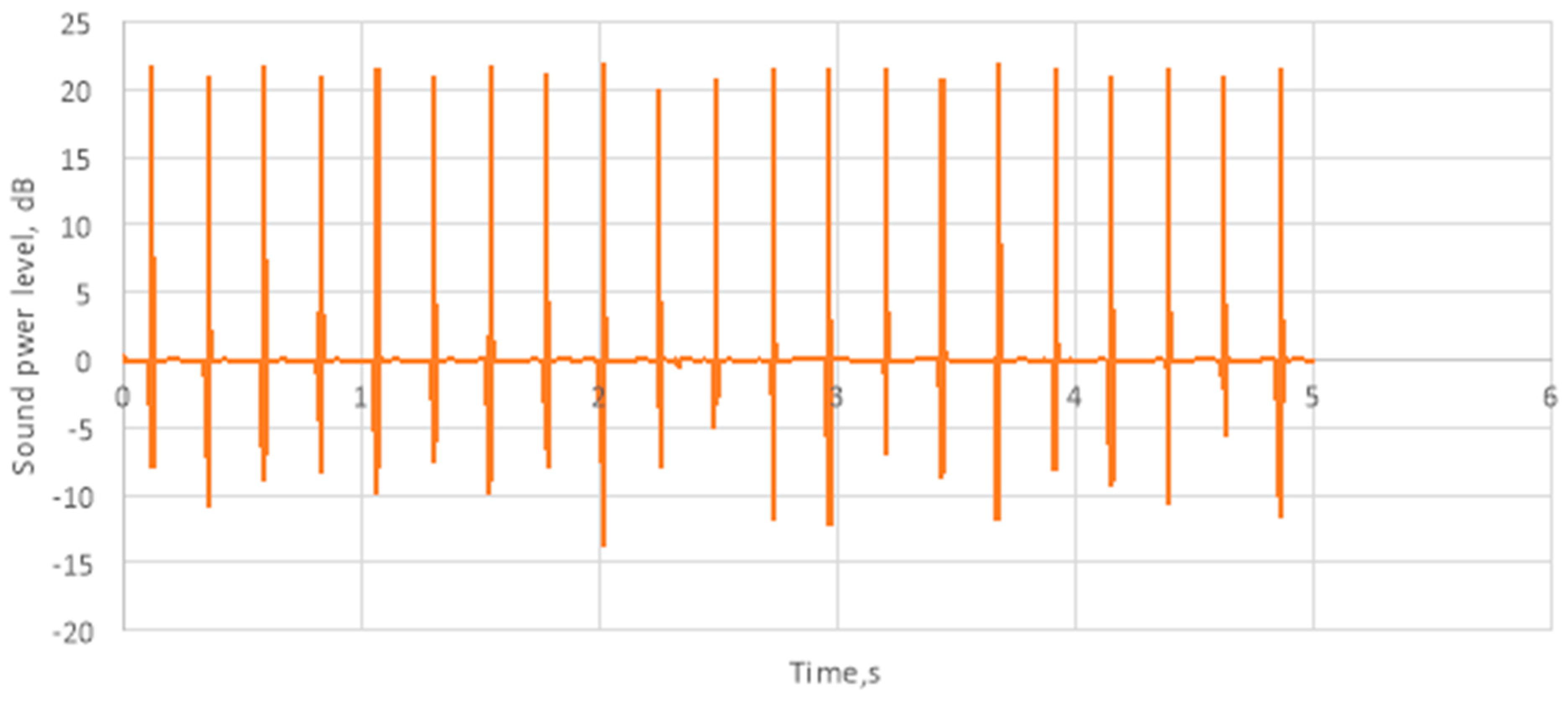


| Category | Allowed Speed, km/h | Rail Type | Mounting Type | Sleepers Type | Ballast |
|---|---|---|---|---|---|
| III | 100/80 | R65 | PANDROL Fastclip | GB | crushed stone |
| Last renovation | Jointed/continuously welded road | Number of defective rails in km/year | Number of defective fasteners, % | Number of defective sleepers, % | Ballast contamination, % |
| 2007 | continuously welded | 3 | 20 | 0 | ≤20 |
| Wheelset | F, kN | Fr, kN | Fref, kN | Frref, kN | t, s | v, m/s |
|---|---|---|---|---|---|---|
| 69 | 364.13 | 469.71 | 183 | 290.66 | 17.738 | 12.86 |
| 71 | 307.84 | 414.08 | 183 | 290.66 | 18.467 | 12.81 |
| 85 | 300.29 | 407.38 | 183 | 290.66 | 22.142 | 12.62 |
| 87 | 323.67 | 427.04 | 183 | 290.66 | 22.945 | 12.59 |
| Wheelset | T, s | f, Hz | ||
|---|---|---|---|---|
| If the Wheel Is New | If It Is Worn | If the Wheel Is New | If It Is Worn | |
| 69 | 0.2320 | 0.2298 | 4.3111 | 4.3523 |
| 71 | 0.2329 | 0.2307 | 4.2943 | 4.3354 |
| 85 | 0.2364 | 0.2341 | 4.2306 | 4.2711 |
| 87 | 0.2369 | 0.2347 | 4.2206 | 4.2610 |
| Wheelset | F, kN | Fr, kN | Fref, kN | Frref, kN | Lw, dB | Lwr, dB |
|---|---|---|---|---|---|---|
| 69 | 364.13 | 469.71 | 25 | 33 | 11.6332 | 11.5332 |
| 71 | 307.84 | 414.08 | 25 | 33 | 10.796 | 10.9857 |
| 85 | 300.29 | 407.38 | 25 | 33 | 10.796 | 10.9149 |
| 87 | 323.61 | 427.04 | 25 | 33 | 11.1208 | 11.1195 |
| Wheelset | Possible Fault Repetition Period T, s (Calculated Time) | Start of the Train Sound Recording, Time t, s |
|---|---|---|
| 69 | 0.0022 (from 0.2320 to 0.2298) | 17.738 |
| 71 | 0.0022 (from 0.2329 to 0.2307) | 18.467 |
| 85 | 0.0023 (from 0.2364 to 0.2341) | 22.142 |
| 87 | 0.0022 (from 0.2369 to 0.2347) | 22.945 |
| Wheelset | Time t, s | Pressure P, Pa |
|---|---|---|
| 69 | 23.3555 | 15.65 |
| 23.5703 | 11.50 | |
| 71 | 24.0820 | 11.71 |
| 24.2871 | 13.83 | |
| 85 | 27.738 | 5.76 |
| 27.967 | 8.5 | |
| 87 | 28.54 | 7.58 |
| 28.81 | 12.33 |
| Wheelset | Time t, s | Sound Pressure P, Pa | Reference Sound Pressure Pref, Pa | Change of Sound Pressure Level Lp, dB | Change of Sound Power Lw, dB |
|---|---|---|---|---|---|
| 69 | 23.3555 | 15.6500 | 4.5000 | 10.8260 | 23.7541 |
| 23.5703 | 11.5000 | 4.5000 | 8.1497 | 21.0778 | |
| 71 | 24.0820 | 11.7100 | 4.5000 | 8.3069 | 21.2350 |
| 24.2871 | 13.8300 | 4.5000 | 9.7522 | 22.6803 | |
| 85 | 27.7380 | 5.7600 | 4.5000 | 2.1442 | 16.6559 |
| 27.9670 | 8.5000 | 4.5000 | 5.5241 | 20.0358 | |
| 87 | 28.5400 | 7.5800 | 4.5000 | 4.5291 | 17.4572 |
| 28.8100 | 12.3300 | 4.5000 | 8.7550 | 21.6831 |
| Wheelset | F, kN | Fr, kN | Fref, kN | Frref, kN | Lw, dB | Lwr, dB |
|---|---|---|---|---|---|---|
| 69 | 364.13 | 469.71 | 25 | 33 | 23.26633 | 23.06632 |
| 71 | 307.84 | 414.08 | 25 | 33 | 21.8077 | 21.97141 |
| 85 | 300.29 | 407.38 | 25 | 33 | 21.59202 | 21.82972 |
| 87 | 323.61 | 427.04 | 25 | 33 | 22.24164 | 22.23909 |
| Wheelset | Speed, m/s | Defect Depth, mm | Wagon Weight, t | Max. Obtained Impact Forces, kN | Min. Obtained Impact Forces, kN | Average Obtained Impact Forces, kN | Reference Obtained Impact Forces, kN | Average Period of Repetition, s |
|---|---|---|---|---|---|---|---|---|
| 69 (Figure 9) | 12.86 | 2 | 91.02 | 334 | 307 | 315 | 25 | 0.232 |
| 71 (Figure 10) | 12.81 | 1.8 | 84.5 | 312 | 285 | 294.96 | 25 | 0.233 |
| 85 (Figure 11) | 12.62 | 1.8 | 84.5 | 306 | 258 | 293.46 | 25 | 0.2364 |
| 87 (Figure 12) | 12.59 | 1.9 | 84.5 | 317 | 282 | 293.73 | 25 | 0.237 |
Publisher’s Note: MDPI stays neutral with regard to jurisdictional claims in published maps and institutional affiliations. |
© 2021 by the authors. Licensee MDPI, Basel, Switzerland. This article is an open access article distributed under the terms and conditions of the Creative Commons Attribution (CC BY) license (http://creativecommons.org/licenses/by/4.0/).
Share and Cite
Kukėnas, V.; Jasevičius, R.; Petrenko, V.; Kilikevičius, A.; Vainorius, D. Analysis of Sound Power Level Changes Caused by Wheel with Flat Spot Using Numerical and Physical Experiment. Appl. Sci. 2021, 11, 2141. https://doi.org/10.3390/app11052141
Kukėnas V, Jasevičius R, Petrenko V, Kilikevičius A, Vainorius D. Analysis of Sound Power Level Changes Caused by Wheel with Flat Spot Using Numerical and Physical Experiment. Applied Sciences. 2021; 11(5):2141. https://doi.org/10.3390/app11052141
Chicago/Turabian StyleKukėnas, Vladas, Raimondas Jasevičius, Viačeslav Petrenko, Artūras Kilikevičius, and Darius Vainorius. 2021. "Analysis of Sound Power Level Changes Caused by Wheel with Flat Spot Using Numerical and Physical Experiment" Applied Sciences 11, no. 5: 2141. https://doi.org/10.3390/app11052141





